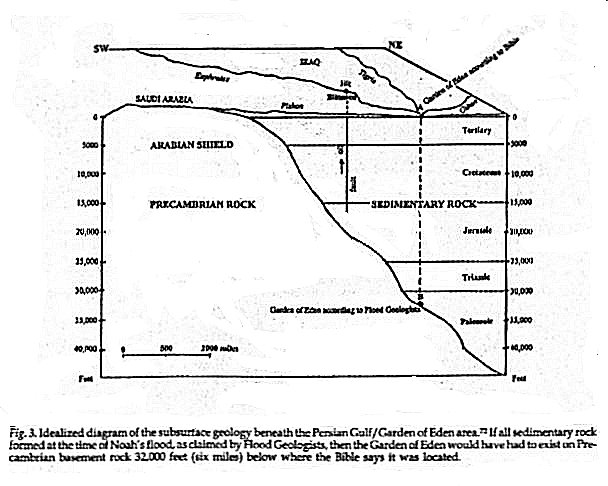Geologist Kent Ratajeski and biologist Joel Duff - both evangelical Christians - along with Dan Phelps, the president of the Kentucky Paleontological Society recently presented their paper "The Ark Encounter: A New Obstacle to Scientific Understanding for the Religious Public in Northern Kentucky" at a recent meeting of the Geographical Society of America. The Ark Encounter, a theme park constructed around a 1:1 replica of Noah's Ark, as interpreted by the fundamentalist organisation Answers in Genesis who are behind this latest attack on mainstream science has attracted controversy on a number of fronts including the dubious means by which AiG could discriminate in hiring people to work on the Ark Encounter, and the questionable decision which allowed AiG to gain tax incentives for the Ark Encounter despite their discriminatory hiring policy and it having an avowedly religious aim.
As regular readers of the blog will know, the evidence against flood geology and young earth creationism is overwhelming, but given the persistence of the pseudoscience of YEC / flood geology and the corrosive effect it has on Christian intellectual life, it cannot be criticised often enough. Ratajeski has now uploaded a video presentation based around the paper he, Duff, and Phelps presented at the GSA meeting.
The twenty minute presentation is a masterly takedown of the YEC position, but one argument Ratajeski makes is worth repeating here. The location of Eden is adjacent to four rivers including the Tigris and Euphrates. This region sits on top of many sedimentary layers which the YECs assert were deposited by the flood. Trouble is, Eden predates the flood. As Ratajeski points out:
Ratajeski's argument is impossible to refute by YECs who place much stock on literal readings of the text, unless they abandon the straightforward reading and posit that the pre-flood location of Eden is buried under the strata, an argument which ignores the fact that the text refers to a modern landscape, a point that geologist Carol Hill, whose 2000 Perspective on Science and Christian Faith article The Garden of Eden: A Modern Landscape ably makes:Flood geology says that the 30, 000 feet of palaeozoic and mesozoic strata underlying this area were all deposited by the flood. So how can the location of Eden, predating the flood, be on top of flood deposits? I consider this one of the best arguments to use when talking to a young earth creationist, since it is a biblical argument, and rests on a straightforward reading of the text. (Emphasis mine) [1]
This interpretation of the Garden of Eden as existing on a modern landscape presents a major conflict between what the Bible says and what flood geologists say. The reason is this: there are six miles of sedimentary rock beneath the Garden of Eden/ Persian Gulf. How could Eden, which existed in pre-flood times, be located over six miles of sedimentary rock supposedly deposited during Noah's flood? What flood geologists are implying is that the Garden of Eden existed on a Precambrian crystalline basement and then Noah's flood came and covered up the Garden of Eden with six miles of sedimentary rock. But this is not what the Bible says. It says that Eden was located where the four rivers confluenced on a modern landscape. It says that the Garden of Eden was located on top of six miles of sedimentary rock, and thus this sedimentary rock must have existed in pre-flood times.
The fact that six miles of sedimentary rock exist beneath the Persian Gulf area is well known by geologists, since this area has been extensively drilled for oil, down to the Precambrian basement. The fact that the Persian Gulf is located in an area of oil recovery is equally as evident to the layperson who, in 1991, witnessed on television the numerous oil fires set off in Kuwait during the Gulf War. The six miles of sedimentary rock below the Garden of Eden area include Tertiary, Cretaceous, Jurassic, Triassic, and Paleozoic rock up to a depth of about 32,000 feet before the Precambrian basement is encountered.
A schematic cross-section of rock that exists below the Persian Gulf/Garden of Eden area is shown in Fig. 3. Note in this figure that Precambrian rock is exposed at the surface in the western part of Saudi Arabia (geologists call this the Arabian Shield), and that this rock becomes progressively overlain by a thicker and thicker sedimentary rock cover north- eastwards, toward Iran. Point A indicates the approximate location of the Garden of Eden according to the Bible and modern geology, and Point B indicates its approximate location according to Flood Geology, since no sedimentary rock supposedly existed at the time of Noah's flood. [2]
Exactly. Flood geology is not just bad science, but even worse Biblical exegesis.How could Noah have obtained bitumen from sedimentary rock for building his ark, if (as claimed by flood geologists) no sedimentary rock existed on earth? One cannot have it both ways. Either Adam and the pre-floodites lived on a Mesopotamian terrain that was vastly different from what exists today, or they lived over a terrain of sedimentary rock. The Bible identifies Eden with four rivers which flowed over and cut into sedimentary rock. The Pishon River (when it flowed) cut into Tertiary sedimentary limestone and sandstone rock near the border of Saudi Arabia and Kuwait. The gold of Havilah is in quartz veins that cut across sedimentary-metamorphic rock. The Karun (Gihon?) River winds around folded and faulted sedimentary rock in western Iran, and the Tigris and Euphrates Rivers encounter sedimentary rock throughout their drainage systems, from the mountains of Turkey to the Persian Gulf. And, the spring of Eden (Eridu?) may have been fed by water from a limestone sedimentary-rock aquifer. All of this is evidence for sedimentary rock being present on earth before Noah's flood rather than it being formed by the flood. (Emphasis mine)
References
1. https://youtu.be/geRFKxUDdlo?t=7m54s
2. Hill C.A. "The Garden of Eden: A Modern Landscape" Perspectives on Science and Christian Faith (2000) 52:31-46
